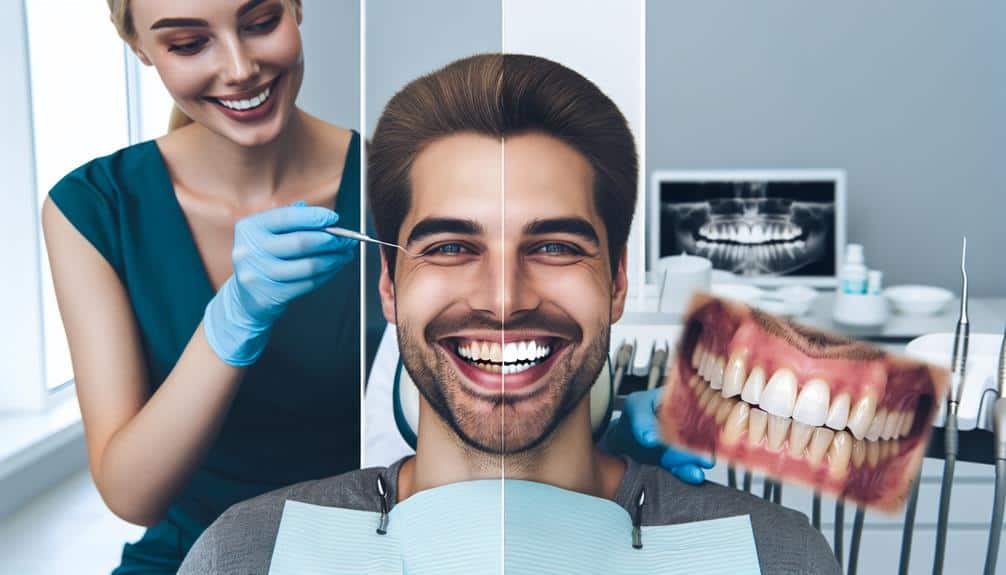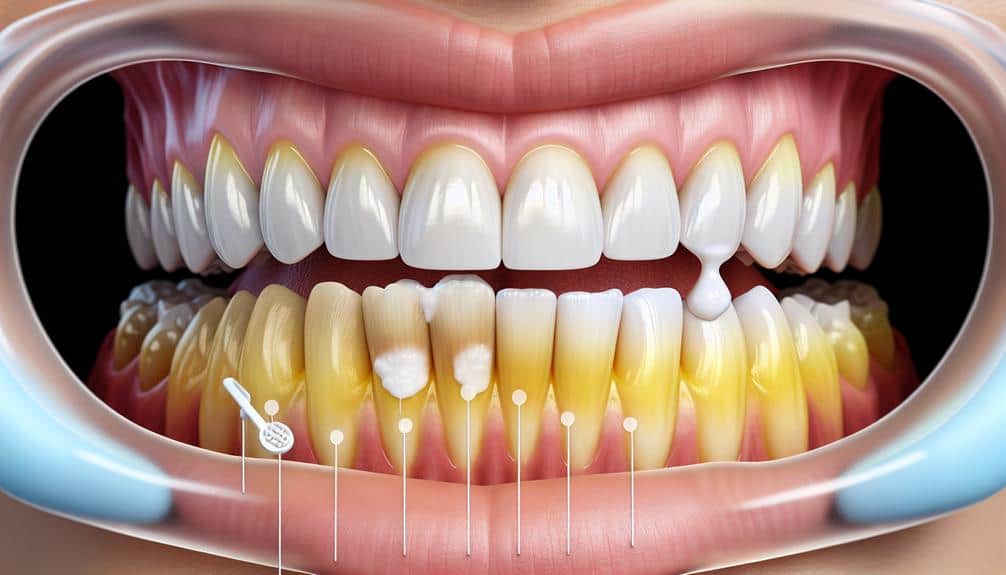When dealing with genetic tooth discoloration, opt for safe whitening methods. Choose whitening toothpaste with gentle abrasives to protect enamel. Use whitening strips cautiously to avoid sensitivity. Consider custom-fitted trays from your dentist for a personalized approach. Professional treatments like in-office bleaching or veneers can provide lasting solutions. Factor in your genetics and oral health when deciding. Maintain results by limiting staining foods, using whitening toothpaste daily, and staying hydrated. For long-term success, explore professional whitening options that suit your needs best. Your brighter smile awaits with safe techniques tailored to your genetic tooth discoloration.
Key Points
- Choose enamel-safe whitening products to protect teeth from damage.
- Consult a dentist for professional whitening options tailored to genetic discoloration.
- Maintain long-term results by avoiding staining foods and beverages.
- Use whitening toothpaste regularly to prevent discoloration.
- Consider custom-fitted whitening trays for a gentle and effective whitening process.
Understanding Genetic Tooth Discoloration
To understand genetic tooth discoloration, it's essential to recognize that certain hereditary factors play a significant role in determining the color of your teeth. Genetics can influence the thickness of enamel, the natural color of dentin, and the overall hue of your teeth. When it comes to causes, genetic tooth discoloration is primarily attributed to variations in genes responsible for enamel formation or mineralization. These genetic variations can lead to teeth appearing more yellow, brown, or grey in color, affecting individuals from a young age.
When considering treatment options for genetic tooth discoloration, it's vital to understand that conventional whitening methods may not be as effective as they're for extrinsic staining. Professional treatments such as in-office bleaching or at-home whitening kits supervised by a dentist can help improve the appearance of genetic tooth discoloration. Additionally, treatments like veneers or bonding can provide long-lasting solutions for individuals seeking to address severe cases of genetic tooth discoloration. Consulting with a dental professional is paramount to determine the most suitable treatment plan tailored to your specific needs.
Factors Influencing Tooth Color
Understanding the various factors that influence the color of your teeth is key to determining appropriate whitening methods for best results. The color of your teeth is influenced by both intrinsic and extrinsic factors.
Intrinsic factors, such as genetics, aging, and certain medications taken during tooth development, can cause tooth discoloration from within. Extrinsic factors, on the other hand, include lifestyle choices like smoking, consuming dark-colored foods and drinks, and poor oral hygiene practices.
To prevent tooth discoloration, it's important to maintain good oral hygiene by brushing and flossing regularly, avoiding tobacco products, and limiting consumption of staining substances. Regular visits to the dentist for professional cleanings can also help prevent surface stains from accumulating.
Understanding the causes of tooth discoloration and taking preventive measures can help you maintain a brighter smile and reduce the need for intensive whitening treatments in the future.
Enamel-Safe Whitening Techniques
Exploring safe and effective methods for whitening your teeth while preserving enamel integrity is essential for achieving a brighter smile without compromising dental health. When considering enamel-safe whitening techniques, it's important to prioritize methods that minimize tooth sensitivity and protect the enamel.
Here are some strategies to help you whiten your teeth safely:
- Choose Whitening Toothpaste: Opt for toothpaste containing gentle abrasives that help remove surface stains without damaging enamel.
- Use Whitening Strips Sparingly: While whitening strips can be effective, using them excessively can lead to tooth sensitivity and enamel erosion.
- Consider Whitening Trays: Custom-fitted whitening trays provided by your dentist can be a safer option compared to over-the-counter trays, as they're tailored to your teeth and reduce the risk of gum irritation.
- Limit Acidic Foods and Beverages: Acidic substances can weaken enamel, making it more susceptible to damage during the whitening process.
- Follow Instructions Carefully: Whether using whitening toothpaste, strips, or trays, always adhere to the recommended usage guidelines to protect your enamel and prevent tooth sensitivity.
Professional Whitening Options
Considering professional whitening options can provide you with a safe and effective way to achieve a brighter smile under the supervision of a dental expert. In a dental office, you can opt for professional whitening treatments that are stronger and more concentrated than over-the-counter products. One popular method involves the use of laser treatment in conjunction with whitening agents to accelerate the whitening process.
Professional whitening treatments conducted in a dental office typically involve a consultation to assess your oral health and determine the best approach for your specific needs. During the procedure, a protective barrier is applied to your gums to shield them from the whitening agents. Then, a specialized whitening solution is carefully applied to your teeth. The laser treatment, when used, helps enhance the effects of the whitening agents, leading to quicker and more noticeable results.
Maintaining Long-Term Whitening Results
To maintain long-term whitening results, it's crucial to establish a consistent oral hygiene routine that includes regular brushing, flossing, and dental check-ups. Alongside these fundamental practices, incorporating specific strategies into your daily routine can help in whitening maintenance and preventing discoloration.
Here are five key tips to aid you in preserving the brightness of your smile:
- Limit Staining Foods and Beverages: Avoid or reduce consumption of coffee, tea, red wine, and other foods known to stain teeth.
- Use Whitening Toothpaste: Incorporate a whitening toothpaste into your daily brushing routine to help remove surface stains and maintain whiter teeth.
- Quit Smoking: Tobacco products can lead to yellowing of teeth, so giving up smoking can greatly contribute to color preservation.
- Stay Hydrated: Drinking plenty of water not only benefits your overall health but also helps wash away food particles that can cause staining.
- Regular Dental Cleanings: Schedule routine dental cleanings to remove any tartar buildup and make sure your teeth stay bright and healthy for the long term.
Frequently Asked Questions
Can Genetic Tooth Discoloration Be Completely Reversed Through Whitening Treatments?
You can enhance the appearance of genetically discolored teeth with whitening treatments, but complete reversal may not be possible due to the underlying genetic predisposition. Consider long-term results and consult with a dental professional for personalized advice.
Are There Any Home Remedies or Natural Treatments That Can Effectively Whiten Genetically Discolored Teeth?
When searching for natural remedies to whiten genetically discolored teeth, it's crucial to evaluate their effectiveness. Many home treatments, while safe, may not deliver the desired results. Consulting with a dental professional can help determine the best approach.
How Long Does It Typically Take to See Noticeable Results From Enamel-Safe Whitening Techniques for Genetic Tooth Discoloration?
You'll typically notice results from enamel-safe whitening techniques for genetic tooth discoloration in a few weeks. Consistent use is key. After achieving desired whiteness, maintain results by following recommended maintenance tips for long-lasting brightness and health.
Are There Any Specific Dietary Changes or Habits That Can Help Prevent Further Discoloration in Genetically Affected Teeth?
To keep your pearly whites gleaming, embrace teeth-friendly habits and dietary changes. Incorporate crunchy fruits and veggies for natural scrubbing action. Ditch sugary snacks and acidic drinks to prevent further discoloration.
Are There Any Potential Risks or Side Effects Associated With Professional Whitening Options for Genetic Tooth Discoloration?
When considering professional whitening for genetic tooth discoloration, potential risks and side effects may include increased tooth sensitivity, gum irritation, or uneven whitening. Consult with a dentist to assess your specific situation before proceeding.



